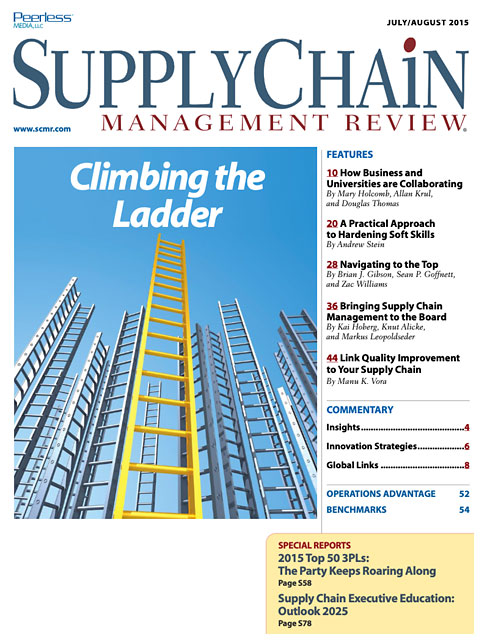Sorry, but your login has failed. Please recheck your login information and resubmit. If your subscription has expired, renew here.
July/August 2015
When it comes to career development, supply chain managers have to execute a bit of jiu jitsu. They’re charged with nding and developing the next generation of talent while simultaneously advancing their own careers in a eld that is often overlooked by senior management. The biggest challenge of all is getting their agenda in front of the Board at a time when supply chain operations are more critical than ever to an organization’s success, but still largely invisible compared to sales, marketing, and product development. Remember: It’s your career—and your supply chain. We hope this month’s issue will help you make the most of both. Browse this issue archive.Need Help? Contact customer service 847-559-7581 More options
Undersupply of supply chain management (SCM) talent has long bedeviled businesses. Since before the turn of the 21st century, a conflagration of forces have conspired to keep supply chain leaders scrambling for the people they need, including globalization, ceaseless technology development, and a perceived lack of cachet and opportunity in the nuts-and-bolts business of logistics.
The problem could well worsen over the next several years. The U.S. Bureau of Labor Statistics projects logistics job growth of 22 percent from 2012-2022, more than double the average rate of the 30 highest growth occupations. Meanwhile, Baby Boomer retirement continues to deplete the ranks of experienced supply chain professionals. Some observers believe the demand for supply chain professionals might now exceed supply by a six-to-one ratio.
 |
This complete article is available to subscribers
only. Click on Log In Now at the top of this article for full access. Or, Start your PLUS+ subscription for instant access. |
The talent squeeze comes as supply chain leaders face dramatically expanding responsibilities. Many are now charged with overseeing the full span of logistical activities from sourcing to production planning to delivery and service.
SC
MR
Sorry, but your login has failed. Please recheck your login information and resubmit. If your subscription has expired, renew here.
July/August 2015
When it comes to career development, supply chain managers have to execute a bit of jiu jitsu. They’re charged with nding and developing the next generation of talent while simultaneously advancing their own careers… Browse this issue archive. Access your online digital edition. Download a PDF file of the July/August 2015 issue.
 |
Download Article PDF |
Undersupply of supply chain management (SCM) talent has long bedeviled businesses. Since before the turn of the 21st century, a conflagration of forces have conspired to keep supply chain leaders scrambling for the people they need, including globalization, ceaseless technology development, and a perceived lack of cachet and opportunity in the nuts-and-bolts business of logistics.
The problem could well worsen over the next several years. The U.S. Bureau of Labor Statistics projects logistics job growth of 22 percent from 2012-2022, more than double the average rate of the 30 highest growth occupations. Meanwhile, Baby Boomer retirement continues to deplete the ranks of experienced supply chain professionals. Some observers believe the demand for supply chain professionals might now exceed supply by a six-to-one ratio.
The talent squeeze comes as supply chain leaders face dramatically expanding responsibilities. Many are now charged with overseeing the full span of logistical activities from sourcing to production planning to delivery and service.
 |
SUBSCRIBERS: Click here to download PDF of the full article. |
SC
MR

Latest Supply Chain News
- Retail sales see gains in October, reports Commerce and NRF
- Balancing green and speed: Home delivery insights from the pandemic era
- AdventHealth named top healthcare supply chain by Gartner
- Geopolitical readiness in supply chains: Strategic challenges for leaders
- Unlocking retention: The role employee engagement plays
- More News
Latest Podcast

 Explore
Explore
Latest Supply Chain News
- Retail sales see gains in October, reports Commerce and NRF
- Balancing green and speed: Home delivery insights from the pandemic era
- AdventHealth named top healthcare supply chain by Gartner
- Geopolitical readiness in supply chains: Strategic challenges for leaders
- Unlocking retention: The role employee engagement plays
- Can supply chain managers embrace an entrepreneurial mindset?
- More latest news
Latest Resources

Subscribe

Supply Chain Management Review delivers the best industry content.

Editors’ Picks





